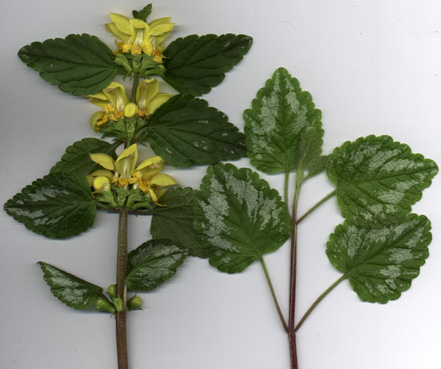Plant of the Month: April 2003
|
| Yellow Archangel or Golden Dead-Nettle |
Lamium Galeobdolon (L.) L.
|
= Lamiastrum Galeobdolon (L.)Ehrend. & Polatschek
|
= Galeobdolon luteum Huds.
|
LABIATÆ; (LAMIACEÆ) Mint Family
|
| A clone of the species Lamium Galeobdolon was introduced from its east European homeland to Seattle gardens, likely in the 1980s, and has proven so rampant that it needs to be spotlighted; people should be warned. Though I do not judge it yet one of the dozen worst weeds in Seattle, it certainly is in the second tier, and as it continues to spread it will become well known. |
| I hasten to add that the genus Lamium consists of around 40 species of Old World perennials or annuals, and all of them known to me in Seattle are either not weedy to any significant degree, or are not weedy period. Several are prized ornamental garden plants (such as Lamium maculatum; spotted dead-nettle). A few have had minor usage in herbal medicine (such as Lamium album; white dead-nettle). Even Lamium Galeobdolon has an array of more-or-less benign cultivars (such as Hermann's Pride). |
| The one clone that is a truly worrisome exception --a scan of which is below-- is placed under the subspecies argentatum (Smejkal) Stace. Probably its correct clonal name is 'Florentinum' but 'Variegatum' has also been used for it. There is confusion in nurseries and plant books. I have spent time to research the history of this clone, but its origin is cloudy. The great likelihood is that it is a tetraploid from SE Europe or SW Asia. |
| It is valued as a groundcover by gardeners because it is strong, easily propagated, needs no irrigation, is evergreen, is lovely, not only endures but brightens dry shady spots, and is non-toxic. All this is good. The problem is that scarcely any plant grows as rapidly in Seattle. When a gardener gets too much and tosses some away, the cast-offs will invade parkland. Your patch will devour your space and invade your neighbor's land too. So acreage is being covered in various places locally, such as in Carkeek Park, Fauntleroy Park, Interlaken Park, Madrona Park, south of NE 110th Street in the 4000 block, and on Luana Beach Road of Maury Island. |
| The flowers appear from April into June. They are lemon-yellow, strongly lipped or divided into an upper hood and a lower portion; each flower is about three-forths of an inch long, and about 10 flowers are congested at each pair of leaves on flowering shoots a foot or two tall. Sweet nectar in the flowers attracts pollinators. I am pleased to have noticed no seedlings yet, and think that this clone spreads vegetatively only. It runs like a strawberry plant to make patches. |
| The green and silver variegated foliage makes it easy to spot the plant. Its leaves are raspy, toothed, wrinkled, hairy, and they are borne opposite one another in neat pairs. They are 1 to 3 or more inches long. The plant stems are prominently square rather than rounded, purplish, and always seem to be elongating. The plant has a characteristic odor that I find unpleasant yet not revolting; certain other plants in the mint family, such as some Stachys and Lycopus species, emit a similar smell. |
For more information about Lamium, note my May 1986 weed of the month article Red Dead-Nettle and my February 1994 weed of the month article Henbit Dead-Nettle.
Back |

Lamium Galeobdolon scan by ALJ
|
|
|

